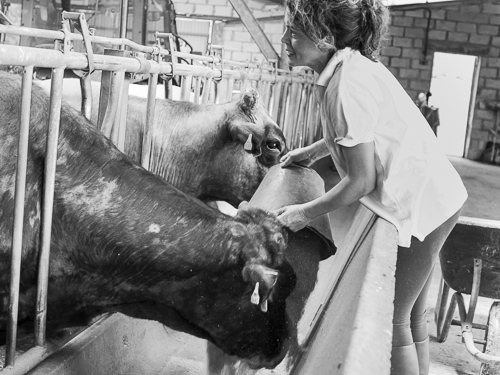We met Sandra Lejarza at the entrance of her farm, which she has been renting for the last seven years. Letting the car of my guide stay, we drove up the steep hill in Sandra’s car until we arrived at a barn which only had walls on three sides. Being situated on the top of a hill, we had a nice view in all directions. Her cattle were staying on a pasture just below the barn and, in order to make them enter the barn, she tried to tempt them inside by hitting a bucket, in which she usually had feed for the cows, and calling to them. This, together with the help of a shepherd dog, it seemed like all the cattle would enter the barn until one cow changed her mind and started wandering to another pasture, being followed by some calves. However much Sandra tried to tempt them to go inside, they didn’t obey her, but they entered the barn on their own volition later.
Inside the barn, she filled the bucket with cereals and poured it into a trough from which the cows were eating. Besides, there were lots of adjacent places where the cows could reach the trough, but it was also intended that a metal bar should be locked as soon as their heads approached the trough. Then, the farmer could ensure that the cows stay till they had finished. However, the ox, which was of the Aubrac race, had so large neck that it wasn’t possible to close the metal bar. Having eaten, some of the cows chose to stay inside, while others went outside.
Having fed the cattle, Sandra turned to making a meal for us, that is me, my guide, herself and Eduardo from the Bizkarra bakery and confectionery, which we had visited earlier in the day. During the cooking, Sandra told us that she had chosen Asturian cattle because they can take care of themselves and they can bear calves on their own. They are beef cattle and they only give milk to their cows. She’s renting the place where she has the cattle and soon she either has to renew the contract or look for somewhere else.
She grew up in a town, married a man from the countryside, and he knew how to breed cows. However, she’s running the farm on her own, while he works in another place. Since the ox is incredibly strong, he helps her when the ox needs to be mated with a cow.
Although the local farmers are very conservative, she’s always open to new ways to improve the running of the farm.
Sandra goes to markets often and she enjoys meeting people. She has teamed up with Eduardo, the owner of the Bizkarra bakery, in order to create a combined product, consisting of four hamburgers with meat from her own cattle and four sourdough breads slowly fermented and not fully baked. In fact, the bread should be baked just before it is eaten.
Both Sandra and Eduardo are persons who are never satisfied with their business, they always feel the need to improve, to introduce new products, to sell their products in different ways and so on. Since both of them also want to use organic and local products as far as possible and using traditional recipes, they work well together.
Sandra also sells meat on Whatsapp. When a calf is getting ready, she sends a message to her customers that they can buy veal and when all the meat of the calf has been sold, the calf is slaughtered. Afterwards, Sandra brings the meat personally to her customers.
Near Sandras´s farm a friend of her, Done, was training for a local rural sport called «Aizkolaritza», and we went to see how he was doing. His wife was measuring the time he used to chop each thick log with an axe and we could realize how hard and intensive this sport must be. Aizkolaritza [ais̻koˈlaɾits̻a] is the Basque name for a type of wood-chopping competition. They are a popular form ofherri kirol (rural sport) in the Basque Country. Competitions are commonly held at most festivals, especially town festivals and usually involve at least two individuals or teams competing against each other.

